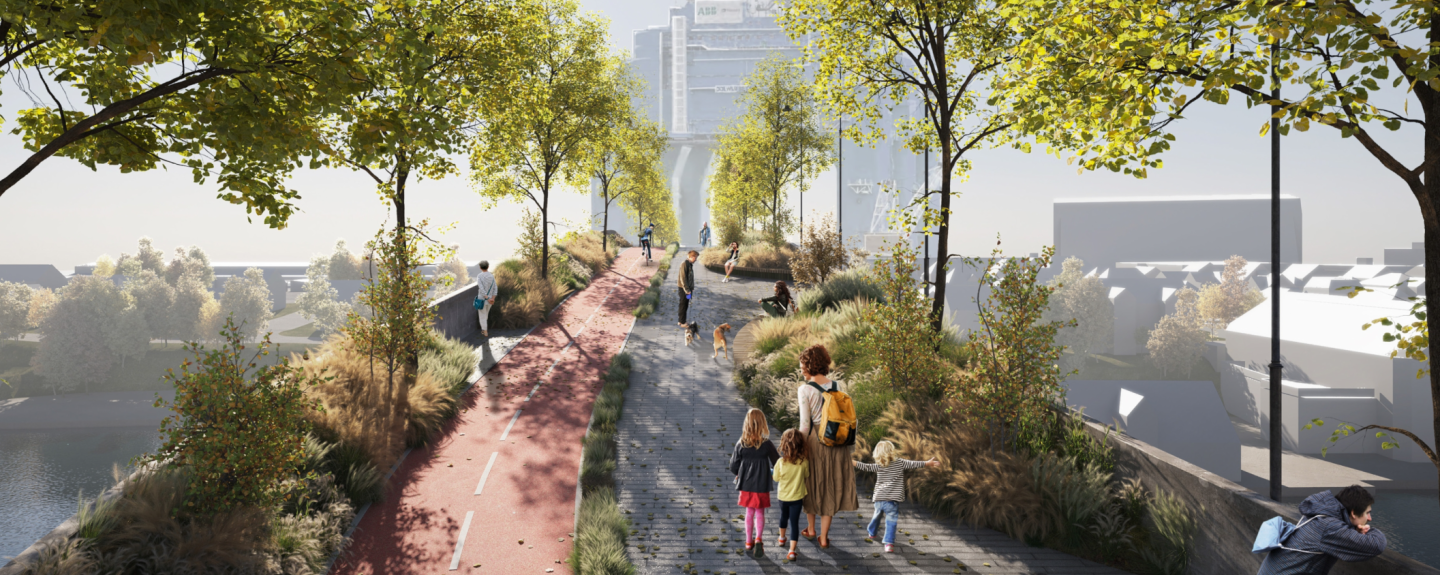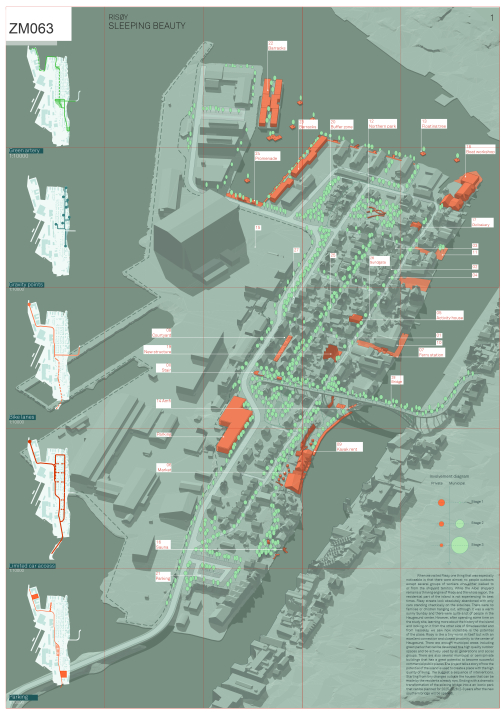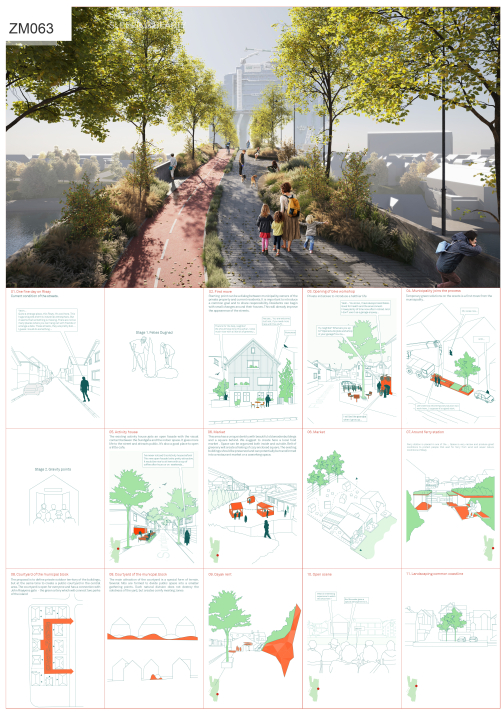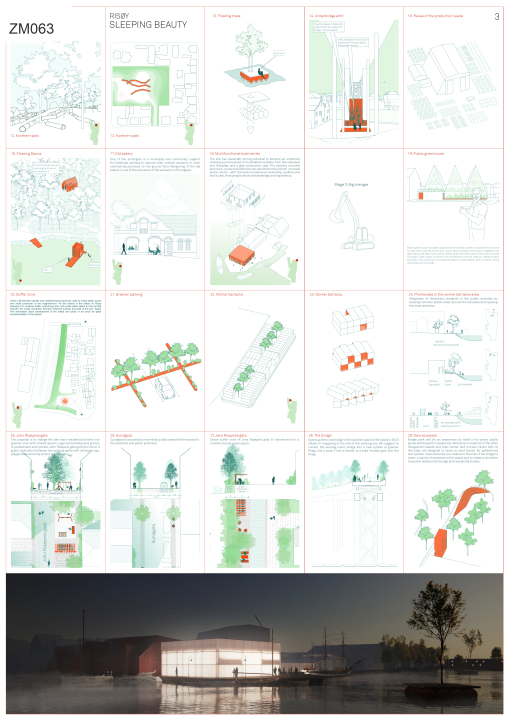Project:
Risøy sleeping beauty

About
-
Risøy is like a tiny world in itself but with an excellent connection and closest proximity to the center of Haugesund. There are enough municipal areas including green parks that can be developed to a high quality outdoor spaces and be actively used by all generations and social groups. There are also several municipal or cemi/private buildings that has a great potential to become succesful commercial public places. The project tells a story of how the potential of the island is used to create a place with the high quality of living. We suggest a sequence of interventions. Starting from tiny changes outside the houses that can be made by the residents already now in 2021 and ending with dramatic transformation of the existing bridge into a an iconic park that can be planned for 2025-2026.
-
Risøy Sleeping beauty received a special mention for the scope of interventions this project proposes. It also offers a clear understanding and a very conscious strategy of working place identity. The jury was also impressed by the attention this project gives to the involvement of the local community and the proposed process to activate residential areas.
-
Associates: Ilya Pugachenko (RU), Alla Aniskova (RU), Andrei Saiko (RU) – architects
Norway 4006 Stavanger, Nedre Holmegate 9B, H0502
+47 96839343
Ilyapugachenko@gmail.com
The team
Team interview
1. How did you form the team for the competition?
We have been friends and colleagues for many years so it was a natural decision for us to work together, even though we live in different countries and work in different companies now. Each of us has our own strengths, which we cherish and which we try to make the most of.
2. How do you define the main issue of your project, and how did you answer on this session main topic, Living cities?
The main issue of the site is the lack of attention, maintenance and investments and, as a result, poor quality of the outdoor and public spaces of Risøy island. At the same time, the site has incredible potential and an excellent location. There are enough municipal areas including green parks that can be developed into high-quality outdoor spaces and be actively used by all generations and social groups. There are also several municipal or semi/private buildings that have a great potential to become successful commercial public places. The project tells a story of how the potential of the island is used to create a place with a high quality of living, a place where people with different backgrounds could communicate and share their experiences. The focus is not on the creation of new buildings, but on the restoration, development and adaptation of existing structures and implementation of greenery.
3. How did the issues on metabolic and inclusive vitalities and the questions raised by the site mutation meet?
The goal of the project is to create strong social connections and social sustainability. The project consists of many small interventions which will have a strong impact on social behaviour and provoke people to act and develop. Small but accurate natural adjustments will help to maximise the usability of the sites that are almost abandoned now. The small architectural adjustments will start big social changes, just like seeds grow into trees in nature.
4. Have you treated this issue previously? What were the reference projects that inspired yours?
We do not have a lot of experience in working with projects with similar issues. We were mostly inspired by the site itself but also referred to the way our colleagues (urbanists and landscape architects) work.
5. Urban-architectural projects like the ones in Europan can only be implemented together with the actors through a negotiated process and in time. How did you consider this issue in your project?
The project presupposes and promotes active involvement of the local community in the process of the activation of the residential area. A starting point can be an arrangement of meetings and dialogues between the municipality, owners of the private property and current residents. It is important to set a common goal and share the responsibility. Residents can begin with the small changes on their properties around their houses. This will already improve the appearance of the streets. Some of them may be eager to transform their properties and create small public places where people could communicate. Gradually the involvement of the municipality becomes more active with bigger transformations of residential streets, parks and squares.
6. Is it the first time you have been awarded a prize at Europan? How could this help you in your professional career?
This is the first time we participate in Europan competition and we are happy that our project is awarded. Although we didn't win, this achievement is beneficial for our CV.
TEAM IDENTITY
Office: -
Function: architecture
Average age of the associates: 35 years old
Has your team, together or separately, already conceived or implemented some projects and/or won any competition? if yes, which ones?
2015 - Beebreders / Bangkok Fashion Hub – 1st Prize
Related projects
-

The third space
The Third Space brings these users and functions together in the heart of the island and divides…
-

Ripples in the water
Through a series of scenarios, the project investigates how developments at Risøy can contribute to…
-

Life in all its settings
We propose to implement a new recreational connection on the edge of Risøy. The Risøy Route has…


